
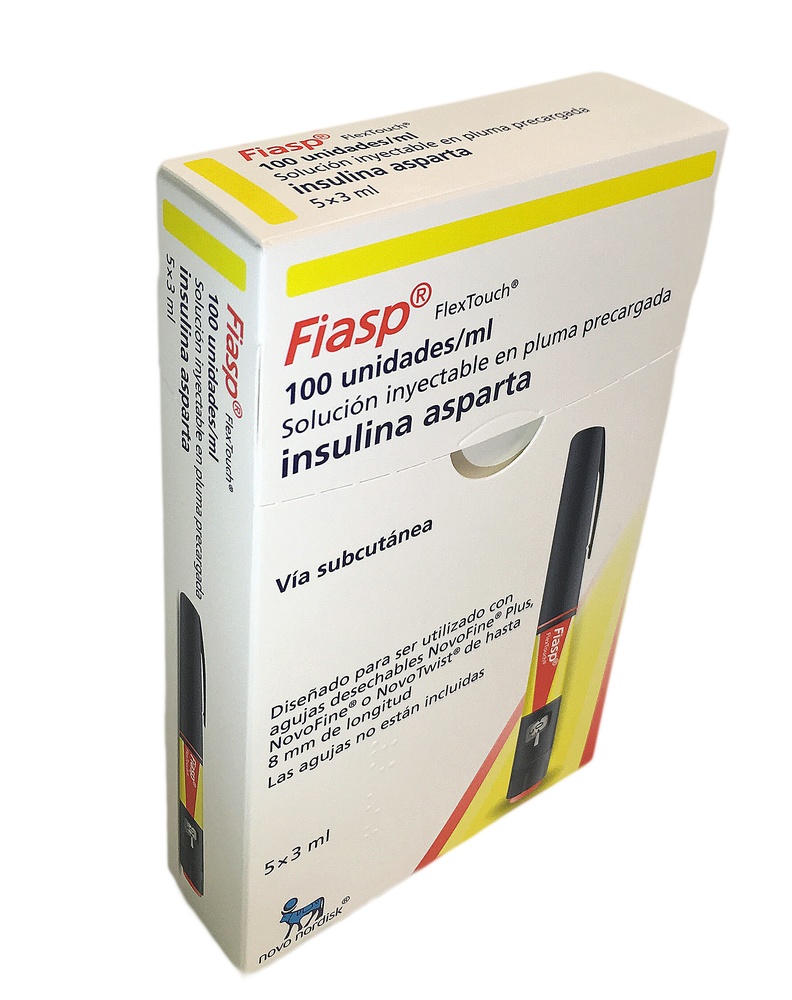
FIASP 100 units/mL FlexTouch prefilled pen solution for injection

Ask a doctor about a prescription for FIASP 100 units/mL FlexTouch prefilled pen solution for injection

How to use FIASP 100 units/mL FlexTouch prefilled pen solution for injection
Introduction
Package Leaflet: Information for the Patient
Fiasp 100units/ml FlexTouch solution for injection in pre-filled pen
insulin aspart
Read all of this leaflet carefully before you start using this medicine because it contains important information for you.
- Keep this leaflet, you may need to read it again.
- If you have any further questions, ask your doctor, pharmacist, or nurse.
- This medicine has been prescribed for you only. Do not pass it on to others. It may harm them, even if their signs of illness are the same as yours.
- If you get any side effects, talk to your doctor, pharmacist, or nurse. This includes any possible side effects not listed in this leaflet. See section 4.
Contents of the pack
- What is Fiasp and what is it used for
- What you need to know before you use Fiasp
- How to use Fiasp
- Possible side effects
- Storage of Fiasp
- Contents of the pack and other information
1. What is Fiasp and what is it used for
Fiasp is an insulin that is administered at mealtimes with a rapid effect of lowering blood sugar. Fiasp is a solution for injection of insulin aspart and is used to treat diabetes mellitus in adults, adolescents, and children from 1 year of age. Diabetes is a disease in which the body does not produce enough insulin to control blood sugar levels. Treatment with Fiasp helps to prevent complications of diabetes. Fiasp should be injected from 2 minutes before starting to eat, with the possibility of administration up to 20 minutes after the start of the meal. This medicine reaches its maximum effect between 1 and 3 hours after injection and the effect lasts between 3 and 5 hours.
This medicine should normally be used in combination with intermediate-acting or long-acting insulins.
2. What you need to know before you use Fiasp
Do not use Fiasp
- if you are allergic to insulin aspart or any of the other ingredients of this medicine (listed in section 6).
Warnings and precautions
Consult your doctor, pharmacist, or nurse before starting to use Fiasp. It is important that you know the following:
- Low blood sugar (hypoglycemia): if your blood sugar level is too low, follow the instructions for low blood sugar that appear in section 4 "Possible side effects". Compared to other insulins that are administered at mealtimes, Fiasp starts to lower blood sugar faster. If you suffer from hypoglycemia, you may feel it sooner after an injection of Fiasp.
- High blood sugar (hyperglycemia): if your blood sugar level is too high, follow the instructions for high blood sugar that appear in section 4 "Possible side effects".
- Change from other insulins. Your doctor may need to advise you on your insulin dose.
- If you are combining your insulin treatment with pioglitazone (an oral antidiabetic medication used to treat type 2 diabetes), talk to your doctor as soon as possible if you experience symptoms of heart failure such as unusual difficulty breathing or rapid weight gain or localized swelling caused by fluid retention (edema).
- Eye disorders: a sudden improvement in blood sugar control can cause a temporary worsening of visual disorders related to diabetes, such as diabetic retinopathy.
- Nerve damage pain: if your blood sugar level improves very quickly, you may experience nerve-related pain that is usually transient.
- Joint swelling: when starting to use the medicine, the body may retain more fluid than it should, causing inflammation of the ankles and other joints. This effect usually disappears quickly.
- Make sure you use the correct type of insulin, always check the insulin label before each injection to avoid accidental mixing of insulins.
- Treatment with insulins can cause the body to produce antibodies to insulin (a substance that acts against insulin). However, only in very rare cases will this require a change in your insulin dose.
In case of reduced vision, see section 3 "How to use Fiasp".
Certain conditions and activities can affect your insulin requirements. Consult your doctor:
- if you have kidney, liver, adrenal, pituitary, or thyroid problems.
- if you do more physical exercise than usual or if you want to change your usual diet, as this can affect your blood sugar level.
- if you are sick, continue your insulin treatment and consult your doctor.
- if you are going to travel abroad, traveling to different time zones can affect your insulin needs and injection times.
When using Fiasp, it is strongly recommended that you record the name and batch number of each pack to keep a record of the batches used.
Changes in the skin at the injection site
The injection site should be rotated to help avoid changes in the fatty tissue, such as thickening of the skin, shrinking of the skin, or lumps under the skin. Insulin may not work very well if it is injected into a swollen, shrunk, or thickened area (see section 3 "How to use Fiasp"). Inform your doctor if you detect any changes in the injection area. Inform your doctor if you are currently injecting into these affected areas, before starting to inject into a different area. Your doctor may indicate that you should check your blood sugar levels more closely and adjust the insulin or dose of your other antidiabetic medications.
Children and adolescents
This medicine is not recommended for use in children under 1 year of age.
Other medicines and Fiasp
Tell your doctor or pharmacist if you are using, have recently used, or might use any other medicines. Some medicines affect your blood sugar level and this may mean that you need to change your insulin dose.
The following are the main medicines that can affect your treatment with insulin.
Your blood sugar level may decrease (hypoglycemia) if you take:
- other diabetes medicines (oral and injectable)
- antibiotics of the sulfonamide type (used to treat infections)
- anabolic steroids (such as testosterone)
- beta-blockers (used to treat high blood pressure or angina pectoris)
- salicylates (used to relieve pain and lower fever)
- monoamine oxidase inhibitors (MAOIs) (used to treat depression)
- angiotensin-converting enzyme inhibitors (ACE inhibitors) (for treating certain heart problems or high blood pressure)
Your blood sugar level may increase (hyperglycemia) if you take:
- danazol (a medicine that acts on ovulation)
- oral contraceptives (birth control pill)
- thyroid hormones (to treat thyroid problems)
- growth hormone (to treat a deficiency of this hormone)
- glucocorticoids (such as "cortisone", to treat inflammation)
- sympathomimetics (such as epinephrine (adrenaline), salbutamol, or terbutaline, to treat asthma)
- thiazides (to treat high blood pressure or if the body retains too much fluid (fluid retention))
Octreotide and lanreotide, used to treat acromegaly, a rare disorder characterized by excessive production of growth hormone. These medicines may increase or decrease your blood sugar level.
If you are in any of the above situations (or are unsure), consult your doctor or pharmacist.
Using Fiasp with alcohol
If you drink alcohol, it may change your insulin needs, as your blood sugar level may be increased or decreased. Therefore, you should check your blood sugar level more frequently than usual.
Pregnancy and breastfeeding
If you are pregnant, think you may be pregnant, or plan to become pregnant, consult your doctor before using this medicine. This medicine can be used during pregnancy, however, it may be necessary to modify the insulin dose while you are pregnant and after delivery. The amount of insulin you need usually decreases during the first 3 months of pregnancy and increases during the remaining 6 months. During pregnancy, careful control of your diabetes is necessary. Avoiding low blood sugar (hypoglycemia) is especially important for the health of your baby. After having your baby, your insulin needs will probably return to what they were before pregnancy.
There are no restrictions on the use of Fiasp during the breastfeeding period.
Driving and using machines
Low blood sugar can affect your ability to drive or use tools or machines. If you have low blood sugar, your ability to concentrate and react may be affected. This could put your life or the lives of others at risk. Ask your doctor if you can drive if:
- you have frequent episodes of hypoglycemia
- you have difficulty recognizing the symptoms of hypoglycemia
Important information about some of the ingredients of Fiasp
This medicine contains less than 1 mmol of sodium (23 mg) per dose; this is, essentially "sodium-free".
3. How to use Fiasp
Follow the instructions for administration of this medicine exactly as indicated by your doctor. In case of doubt, consult your doctor or pharmacist again.
If you are blind or have reduced vision and cannot read the dose counter on the pen, do not use this pen without help. Ask for help from a person without vision problems and who is trained in the use of the pre-filled FlexTouch pen.
The pre-filled pen can provide a dose of 1-80 units in one injection, in increments of 1 unit.
When to use Fiasp
Fiasp is an insulin that is administered at mealtimes.
Adults: Fiasp should be injected just before (0-2 minutes) starting to eat, with the possibility of administration up to 20 minutes after the start of the meal.
Children: Fiasp should be injected just before (0-2 minutes) starting to eat, with the possibility of administration up to 20 minutes after the start of the meal in situations where it is uncertain when the child will eat. Consult your doctor about these situations.
This medicine reaches its maximum effect between 1 and 3 hours after injection and the effect lasts between 3 and 5 hours.
Dose of Fiasp
Dose for type 1 and type 2 diabetes
Your doctor will decide together with you:
- how much Fiasp you need at each meal
- when to check your blood sugar level and if you need a higher or lower dose
If you want to change your usual diet, consult your doctor, pharmacist, or nurse beforehand, as a change in diet can alter your insulin needs.
When using other medicines, ask your doctor if it is necessary to adjust your treatment.
Dose adjustment for type 2 diabetes
The daily dose depends on your blood sugar level at mealtimes the previous day and the previous night.
- Before breakfast: the dose should be adjusted according to the blood sugar level before lunch the previous day.
- Before lunch: the dose should be adjusted according to the blood sugar level before dinner the previous day.
- Before dinner: the dose should be adjusted according to the blood sugar level the previous night.
Table 1 Dose adjustment | ||
Blood sugar level at mealtimes or at night | Dose adjustment | |
mmol/l | mg/dl | |
less than 4 | less than 71 | Reduce the dose by 1 unit |
4-6 | 71-108 | No dose adjustment is needed |
more than 6 | more than 108 | Increase the dose by 1 unit |
Use in elderly patients (65 years or older)
This medicine can be used in elderly patients. Talk to your doctor about possible changes in your dose.
If you have kidney or liver problems
If you have kidney or liver problems, you may need to check your blood sugar level more frequently. Talk to your doctor about possible changes in your dose.
Injecting Fiasp
This medicine is only intended for injection under the skin (subcutaneous injection).
Before using Fiasp for the first time, your doctor or nurse will show you how to use the pre-filled pen. Consult your doctor if you need to inject the insulin by another method.
Where to inject
- The best areas for injection are the front of the waist (abdomen) or the upper arm.
- Do not inject into a vein or muscle.
- Change the injection site every day within the area where you inject to reduce the risk of developing changes under the skin (see section 4).
Do not use Fiasp
- if the pen is damaged or has not been stored correctly (see section 5 "Storage of Fiasp").
- if the insulin does not have a clear and colorless appearance (e.g. cloudy).
Detailed instructions on how to use the FlexTouch pen are provided on the other side of this leaflet
If you use more Fiasp than you should
If you use too much insulin, your blood sugar level may become very low (hypoglycemia), see section 4 "Low blood sugar".
If you forget to use Fiasp
If you forget to inject the insulin, your blood sugar level may become very high (hyperglycemia). See section 4 "High blood sugar".
Three simple steps that can help you avoid low or high blood sugar levels:
- Always carry a spare pen in case you lose or damage yours.
- Always carry something that indicates you are diabetic.
- Always carry sugary products with you. See section 4 "What to do if your blood sugar level is low".
If you stop using Fiasp
Do not stop your insulin treatment without consulting your doctor. Stopping the administration of insulin could cause a very high blood sugar level (severe hyperglycemia) and ketoacidosis (a potentially fatal condition that consists of an excess of acid in the blood). See symptoms and recommendations in section 4 "High blood sugar".
4. Possible Adverse Effects
Like all medicines, this medicine can cause adverse effects, although not all people suffer from them.
Low blood sugar level (hypoglycemia)is a very frequent adverse effect of insulin treatment (it can affect more than 1 in 10 people). It can be very serious. A severe drop in blood sugar can lead to loss of consciousness. Severe hypoglycemia can cause brain damage and put your life at risk. If you experience symptoms of low blood sugar, take measures to increase your blood sugar level immediately. See the recommendations "Low blood sugar level" below.
If you experience a severe allergic reaction(including anaphylactic shock) to insulin or any of the components of Fiasp (the frequency of which is unknown), discontinue treatment with this medicine and contact the emergency medical service immediately.
The symptoms of a severe allergic reaction may include:
- local reactions (such as rash, redness, and itching) spreading to other parts of the body
- sudden feeling of illness with sweating
- starting to vomit
- experiencing difficulty breathing
- having palpitations or feeling dizzy
Allergic reactionssuch as widespread skin rash and facial swelling may occur. These are uncommon and may affect up to 1 in 100 people. Consult a doctor if symptoms worsen or if you see no improvement within a few weeks.
Changes in the skin at the injection site:If insulin is injected in the same place, the fatty tissue can shrink (lipoatrophy) or become thicker (lipohypertrophy) (these are uncommon and may affect up to 1 in 100 people). Lumps under the skin can also occur due to the accumulation of a protein called amyloid (cutaneous amyloidosis; the frequency of which is unknown). Insulin may not work very well if injected into a lumpy, shrunken, or thickened area. Change the injection site to help avoid these skin changes.
Other adverse effects include:
Frequent(may affect up to 1 in 10 people)
Reaction at the administration site: Localized reactions may appear at the injection site. Symptoms may include: rash, redness, inflammation, bruising, irritation, pain, and itching. These reactions usually disappear after a few days.
Skin reactions: Signs of skin allergy such as eczema, rash, itching, hives, and dermatitis may appear.
General effects of insulin treatment, including Fiasp
- Low blood sugar level (hypoglycemia) (very frequent)
Low blood sugar levels may occur if:
You drink alcohol, inject too much insulin, exercise more than usual, eat very little, or skip a meal.
Warning symptoms of low blood sugar, which can appear suddenly:Headache, difficulty speaking, palpitations, cold sweat, cold and pale skin, nausea, excessive hunger, trembling, nervousness or anxiety, unusual fatigue, weakness, and drowsiness, confusion, difficulty concentrating, temporary changes in vision.
What to do if your blood sugar level is low
- If you are conscious, treat your low blood sugar immediately with 15-20 g of fast-acting carbohydrates: take glucose tablets or a sugary product, such as fruit juice, sweets, or cookies (always carry glucose tablets or sugary products with you in case you need them).
- It is recommended that you recheck your blood glucose levels after 15-20 minutes and retreat if your blood glucose levels are still below 4 mmol/l.
- Wait until the symptoms of hypoglycemia have disappeared or your blood sugar level has stabilized. Continue with your insulin treatment as usual.
What people close to you should do if you lose consciousness
Inform the people you spend time with that you have diabetes. Tell them what the consequences of low blood sugar might be, including the risk of losing consciousness.
Tell them that if you become unconscious, they should do the following:
- lay you on your side to prevent choking
- seek immediate medical attention
- not give you anything to eat or drink, as you might choke
You may regain consciousness more quickly if someone who knows how to do so administers a glucagon injection to you.
- If you are given glucagon, you should take glucose or a sugary product as soon as you regain consciousness.
- If you do not respond to glucagon treatment, you should be treated in a hospital.
If severe hypoglycemia is not treated, it can cause brain damage over time. This can be temporary or permanent. It can even lead to death.
Talk to your doctor if:
- you have had low blood sugar levels that have caused you to lose consciousness
- you have been given a glucagon injection
- you have had several episodes of low blood sugar recently
You may need to adjust the dose or frequency of your insulin injections, diet, or exercise.
- High blood sugar level (hyperglycemia)
High blood sugar levels may occur if:
You eat more or exercise less than usual, drink alcohol, have an infection or fever, do not inject enough insulin, repeatedly inject less insulin than you need, forget to inject insulin, or interrupt your insulin treatment.
Warning symptoms of high blood sugar, which usually appear gradually:Redness of the skin, dry skin, feeling of drowsiness or fatigue, dry mouth, fruity breath odor (acetone), increased need to urinate, thirst, loss of appetite, nausea, or vomiting.
These can be symptoms of a very serious condition called ketoacidosis. It is an accumulation of acid in the blood because the body is metabolizing fat instead of sugar. If left untreated, it can lead to diabetic coma and even death.
What to do if your blood sugar level is high
- Check your blood sugar level.
- Administer a correction dose of insulin if you have been taught how to do so.
- Check your urine ketone level.
- If you have ketones, seek immediate medical attention.
Reporting adverse effects
If you experience any adverse effects, consult your doctor, pharmacist, or nurse, even if they are not listed in this leaflet. You can also report them directly through the Spanish Pharmacovigilance System for Human Use Medicines: https://www.notificaram.es. By reporting adverse effects, you can contribute to providing more information on the safety of this medicine.
5. Storage of Fiasp
Keep this medicine out of the sight and reach of children.
Do not use this medicine after the expiry date stated on the label and carton after EXP. The expiry date is the last day of the month indicated.
Before first use
Store in a refrigerator (between 2°C and 8°C). Do not freeze. Keep away from the freezer. Store the pen with the cap on to protect it from light.
Once opened or when carried as a spare
You can carry your pre-filled pen (FlexTouch) with you and store it at room temperature (not above 30°C) or in a refrigerator (between 2°C and 8°C) for 4 weeks. Always store the pen with the cap on when not in use to protect it from light.
Medicines should not be disposed of via wastewater or household waste. Ask your pharmacist how to dispose of the packaging and any unused medicines. This will help protect the environment.
6. Container Contents and Additional Information
Fiasp Composition
- The active ingredient is insulin aspart. 1 ml of solution contains 100 units of insulin aspart. Each pre-filled pen contains 300 units of insulin aspart in 3 ml of solution.
- The other components are phenol, metacresol, glycerol, zinc acetate, disodium phosphate dihydrate, arginine hydrochloride, nicotinamide (vitamin B3), hydrochloric acid (for pH adjustment), sodium hydroxide (for pH adjustment) (see the end of section 2 "Important information about some of the components of Fiasp") and water for injectable preparations.
Appearance of Fiasp and Container Contents
Fiasp is presented as a clear, colorless, and aqueous injectable solution in a pre-filled pen.
Container sizes are 1, 5, or a multiple container with 2 x 5 pre-filled pens of 3 ml. Not all container sizes may be marketed.
Marketing Authorization Holder and Manufacturer
Novo Nordisk A/S,
Novo Allé,
DK-2880 Bagsværd, Denmark
Date of Last Revision of this Leaflet:
Other Sources of Information
Detailed information on this medicinal product is available on the European Medicines Agency website: http://www.ema.europa.eu.
Instructions for Using Fiasp FlexTouch
Read these instructions carefullybefore using your pre-filled FlexTouch pen. If you do not follow the instructions carefully, you may administer too little or too much insulin, which could lead to high or low blood sugar levels.
Do not use the pen without proper trainingfrom your doctor or nurse.
Start by checking the pen to make sure it contains Fiasp 100units/mland then look at the illustrations to familiarize yourself with the different parts of the pen and needle.
If you are blind or have reduced vision and cannot read the dose counter on the pen, do not use this pen without assistance.Seek help from a person without visual problems and who is trained in the use of the pre-filled FlexTouch pen.
Your pen is a pre-filled insulin dosing pen that contains 300 units of insulin. You can select a maximum of 80units per dose in increments of 1unit.Your pen is designed to be used with disposable, single-use injectable needles between 4 mm and 8 mm in length and a gauge between 30 G and 32 G. Needles are not included in the container.
Important Information
Pay special attention to these notes because they are important for the correct use of the pen.
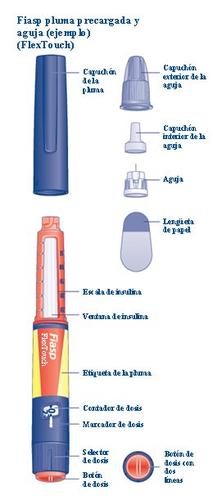
1 Preparing the Pen with a New Needle
- Check the name and concentration on the label of your pen to ensure it contains Fiasp 100 units/ml. This is especially important if you use more than one type of insulin. If you use the wrong type of insulin, your blood sugar level may be too high or too low.
- Remove the pen cap.
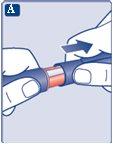
- Check that the insulin in the pen has a clear and colorless appearance.
Look through the insulin window. If the insulin appears cloudy, do not use the pen.

- Take a new needle and remove the paper tab.

Make sure to place the needle correctly.
- Place the needle straight onto the pen.
- Screw it on until it is tight.

The needles are covered by two caps. You must remove both caps.If you forget to remove both, you will notinject any insulin.
- Remove the outer needle cap and set it aside for later. You will need it after the injection to safely remove the needle from the pen.

- Remove the inner needle cap and discard it. If you try to put it back on, you may damage it or accidentally prick yourself with the needle.
A drop of insulin may appear at the tip of the needle. This is normal, but you must still check the insulin flow.
Do not put a new needleon the pen until you are ready to take the injection.

Always use a new needlefor each injection.
This reduces the risk of contamination, infection, loss of insulin, needle blockage, and inaccurate dosing.
Never use a bent or damaged needle.
2 Checking the Insulin Flow
- Always check the insulin flow before starting.
This will help ensure you receive the full insulin dose.
- Turn the dose selector until 2 units are selected. Make sure a 2 appears in the dose counter.
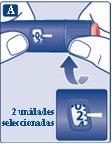
- Hold the pen with the needle pointing upwards.
Gently tap the top of the penseveral times to make any air bubbles rise.

- Press and hold the dose button until the dose counter returns to 0.
The 0 must be aligned with the dose marker.
A drop of insulin must appear at the tip of the needle.
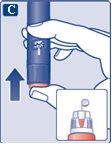
A small air bubble may remain at the tip of the needle, but it will not be injected.
If a drop does not appear,repeat steps 2A to 2C up to 6 times. If a drop still does not appear, change the needle and repeat steps 2A to 2C once more.
If, despite this, a drop of insulin does not appear, discard the pen and use a new one.
Always make sure a drop appearsat the tip of the needle before injecting. This ensures the insulin is flowing correctly.
If a drop does not appear, no insulin will be injected, even if the dose counter moves. This may indicate that the needle is blocked or damaged.
Always check the insulin flow before injecting.If you do not check the flow, you may receive too little or no insulin. This could lead to high blood sugar levels.
3 Selecting the Dose
- Check that the dose counter shows 0 before starting.
The 0 must be aligned with the dose marker.
- Turn the dose selector to select the dose you need, following the instructions of your doctor or nurse.
If you have selected a wrong dose, you can turn the dose selector forward or backward until you select the correct dose.
The pen can select up to a maximum of 80 units.
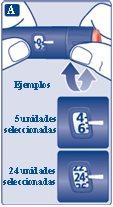
The dose selector changes the number of units. Only the dose counter and dose marker show how many units you have selected for each administration.
You can select up to 80 units per administration. When the pen contains less than 80 units, the dose counter stops when it reaches the number of units left.
Always use the dose counter and dose marker to see how many units you have selected.
Do notcount the pen's clicks to set the dose. If you select a wrong dose and inject it, your blood sugar level may become too high or too low.
Do not use the insulin scale, as it only indicates the approximate amount of insulin left in the pen.
The dose selector clicks differently when turned forward, backward, or when passing the number of units left.
4 Injecting the Dose
- Insert the needle under the skin, as your doctor or nurse has explained.
- Check that you can see the dose counter.
Do not touch the dose counter with your fingers. This could interrupt the injection.

- Press and hold the dose button. Watch as the dose counter returns to 0.
The 0 must be aligned with the dose marker. You may hear or feel a click.
- Continue to press the dose button while keeping the needle in the skin.

- Count slowly to 6 while keeping the dose button pressed.
- If you remove the needle before, you may see insulin coming out of the needle tip. This means you have not received the full dose, so you should check your blood sugar level more frequently.
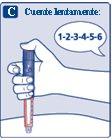
- Remove the needle from the skin. You can then release the dose button.
If you see blood at the injection site, press the skin gently for a few minutes to stop the bleeding. Do not rub the area.

A drop of insulin may appear at the tip of the needle after the injection. This is normal and does not affect the dose.
Always watch the dose counter to know how many units you are injecting.Keep the dose button pressed until the dose counter shows 0. If the dose counter does not return to 0, it means you have not received the full dose, which could result in high blood sugar levels.
How to detect if the needle is blocked or damaged?
- If the 0 does not appear in the dose counter after continuously pressing the dose button, you may have used a blocked or damaged needle.
- In this case, you will not have received any medication, even though the dose counter has moved from the original dose you set.
What to do if the needle is blocked?
Remove the needle as described in section 5 and repeat all the steps from section 1: Preparing the pen with a new needle. Make sure to select the full dose you need.
Never touch the dose counter while injecting.
This can interrupt the injection.
5 After the Injection
Always discard the needle after each injection.
This reduces the risk of contamination, infection, loss of insulin, needle blockage, and inaccurate dosing. If the needle is blocked, noinsulin will be injected.
- Insert the needle tip into the outer cap, placed on a flat surface, without touching the needle or the outer cap.

- When the needle is covered, carefully press the outer cap completely.
- Unscrew the needle and carefully discard it as instructed by your doctor, nurse, pharmacist, or local authorities.

- Put the cap back on the pen after each use to protect the insulin from light.

When the pen is empty, discard it withoutthe needle attached, following the instructions of your doctor, nurse, pharmacist, or local authorities.
Never try to put the inner needle cap back on.You could prick yourself or damage it.
Always remove the needle from the pen after each injectionand store your pen without the needle attached. This reduces the risk of contamination, infection, loss of insulin, needle blockage, and inaccurate dosing.
6 How Much Insulin is Left?
- The insulin scale shows the approximate amount of insulin left in the pen.

- To know exactly how much insulin is left, use the dose counter:
Turn the dose selector until the dose counter stops.
If it shows 80, it means there are at least 80unitsleft in the pen.
If it shows less than 80,the number shows the amount of units left in the pen.
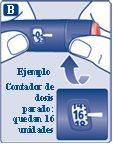
- Turn the dose selector backward until the dose counter shows 0.
- If you need more insulin than the units left in the pen, you can divide the dose between two pens.
Be very careful when doing the calculation if you divide your dose.
If you are not sure, inject the full dose with a new pen. If you incorrectly divide the dose, you may inject too little or too much insulin, which can lead to high or low blood sugar levels.
More Important Information
- Always carry the pen with you.
- Always carry a spare pen and new needles in case of loss or breakage.
- Always keep the pen and needles out of sight and reach of others, especially children.
- Never share the pen or needles with others. Infections may occur.
- Never share the pen with others. Your medication may be harmful to them.
- People caring for patients must be careful when handling used needles to reduce the risk of needle damage and infection.
Care of the Pen
- Treat your pen with care. Rough handling or misuse can cause inaccurate dosing, leading to high or low blood sugar levels.
- Do not leave the pen in a car or other location where it can become too hot or too cold.
- Do not expose the pen to dust, dirt, or liquids.
- Do not wash, soak, or lubricate the pen. If necessary, clean it with a damp cloth and a mild detergent.
- Make sure the pen does not fall or hit hard surfaces.
If you drop the pen or suspect it has a problem, put a new needle on and check the insulin flow before injecting.
- Do not attempt to refill the pen.Once empty, it must be discarded.
Do not attempt to repair the penor disassemble it.

How much does FIASP 100 units/mL FlexTouch prefilled pen solution for injection cost in Spain ( 2025)?
The average price of FIASP 100 units/mL FlexTouch prefilled pen solution for injection in December, 2025 is around 43.21 EUR. Prices may vary depending on the region, pharmacy, and whether a prescription is required. Always check with a local pharmacy or online source for the most accurate information.
- Country of registration
- Average pharmacy price43.21 EUR
- Availability in pharmaciesSupply issue reported
- Active substance
- Prescription requiredYes
- Manufacturer
- This information is for reference only and does not constitute medical advice. Always consult a licensed doctor before taking any medication. Oladoctor is not responsible for medical decisions based on this content.
- Alternatives to FIASP 100 units/mL FlexTouch prefilled pen solution for injectionDosage form: INJECTABLE, 100 U/mlActive substance: insulin aspartManufacturer: Novo Nordisk A/SPrescription requiredDosage form: INJECTABLE, 100 U/mlActive substance: insulin aspartManufacturer: Novo Nordisk A/SPrescription requiredDosage form: INJECTABLE, 100 U/mlActive substance: insulin aspartManufacturer: Novo Nordisk A/SPrescription required
Alternatives to FIASP 100 units/mL FlexTouch prefilled pen solution for injection in other countries
The best alternatives with the same active ingredient and therapeutic effect.
Alternative to FIASP 100 units/mL FlexTouch prefilled pen solution for injection in Ukraine
Online doctors for FIASP 100 units/mL FlexTouch prefilled pen solution for injection
Discuss dosage, side effects, interactions, contraindications, and prescription renewal for FIASP 100 units/mL FlexTouch prefilled pen solution for injection – subject to medical assessment and local rules.














